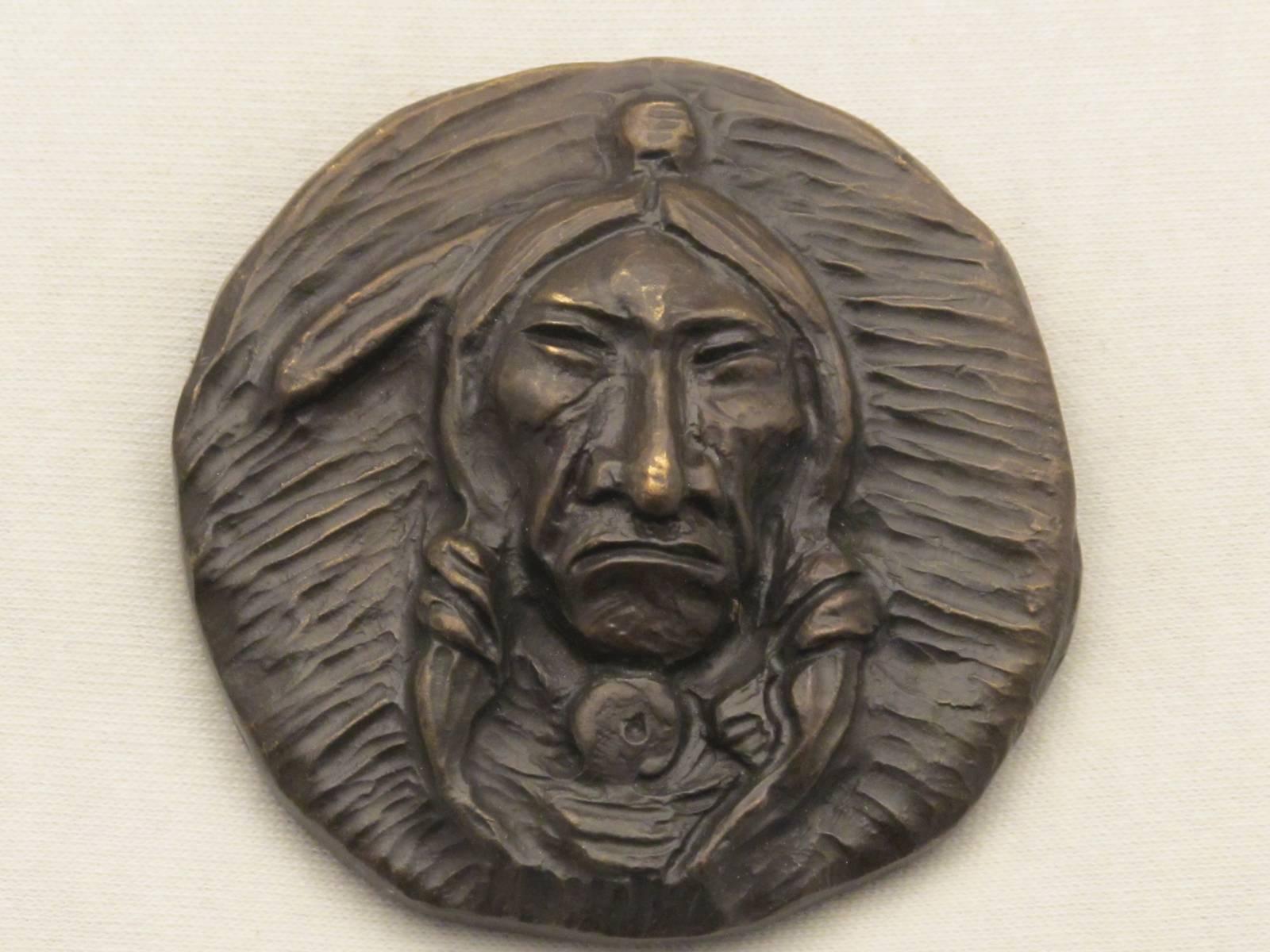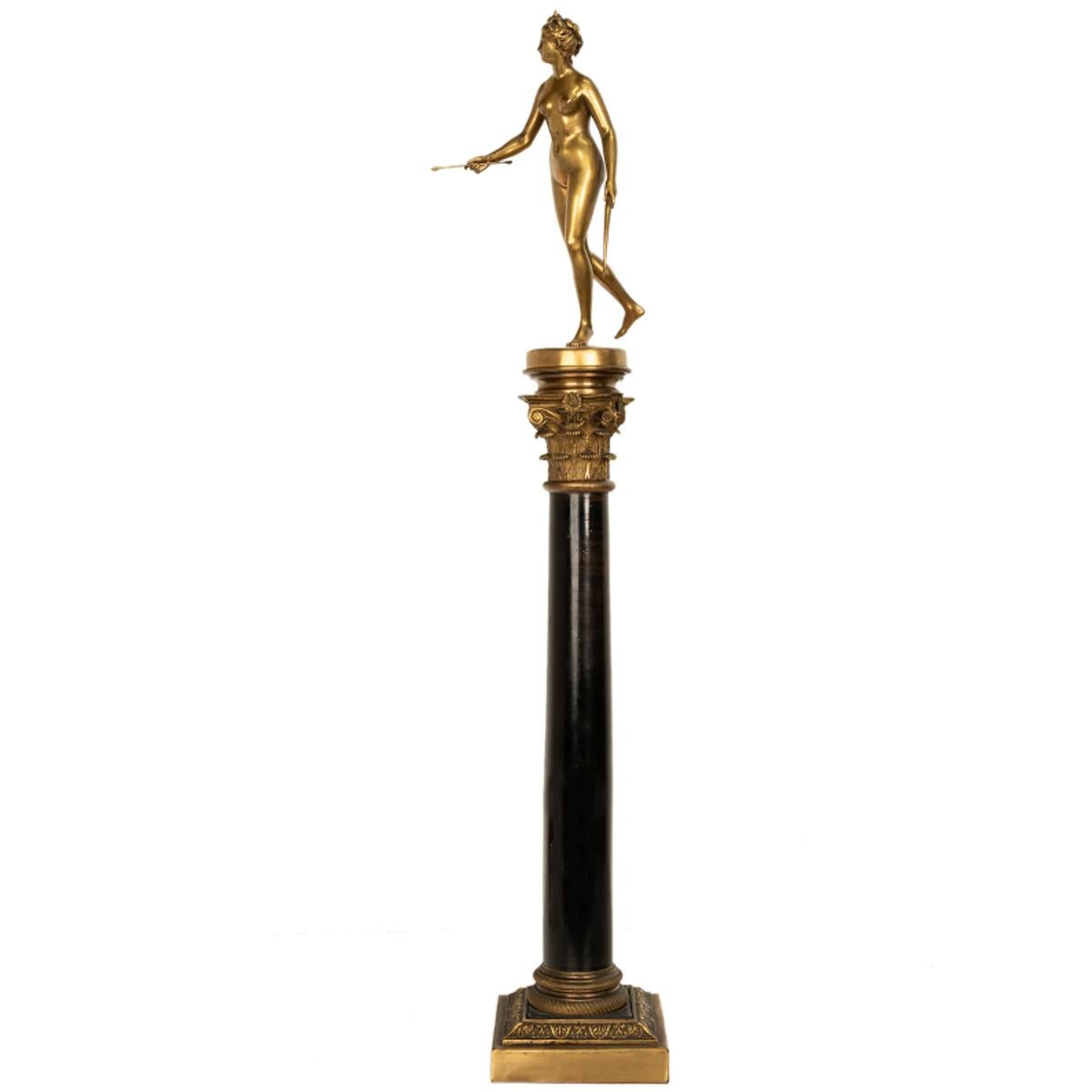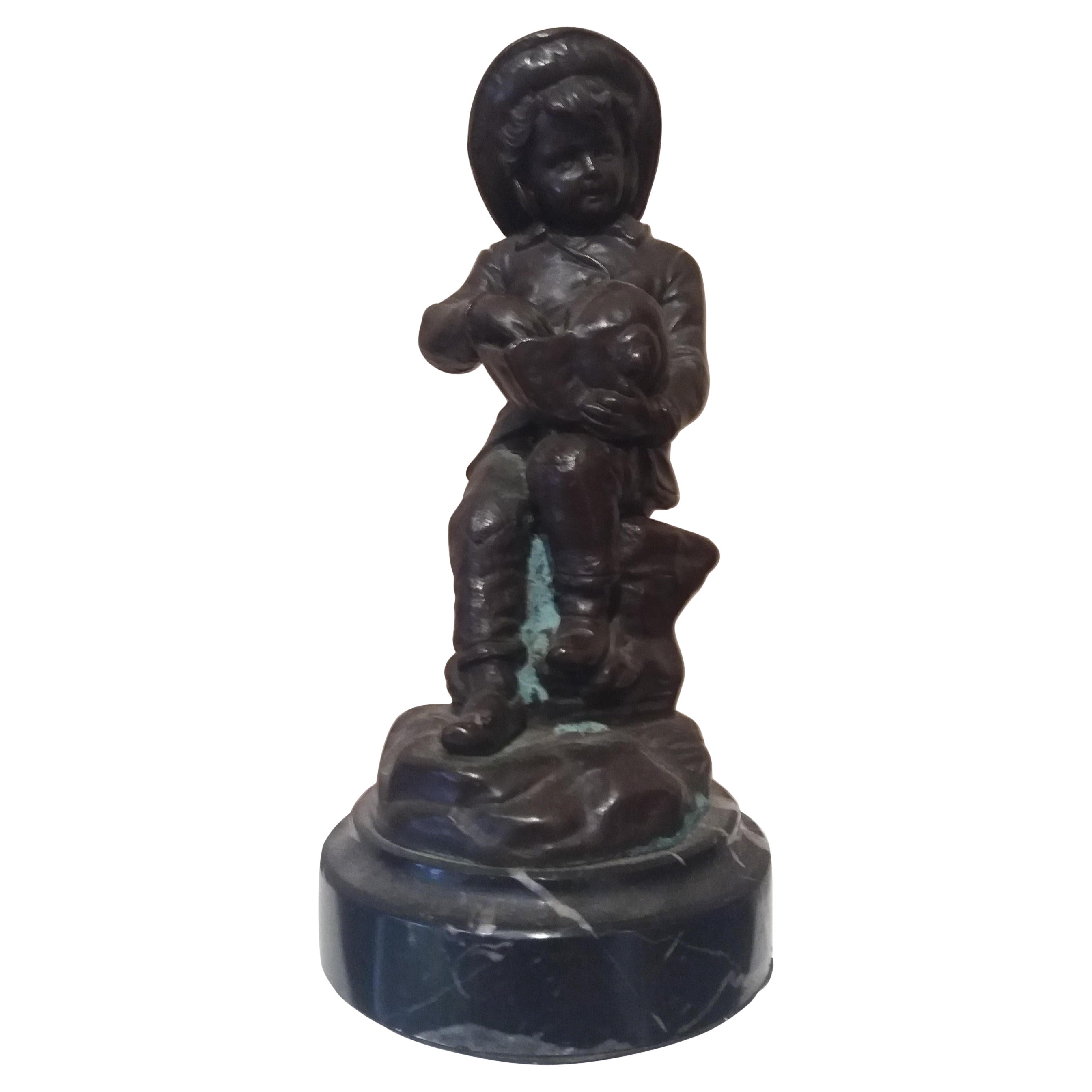Items Similar to Sea Lion by Greta van Puyenbroeck (1943- )
Want more images or videos?
Request additional images or videos from the seller
1 of 4
Greta van PuyenbroeckSea Lion by Greta van Puyenbroeck (1943- )
About the Item
sea lion
Artist: Greta van Puyenbroeck
Dimensions: 22 h x 44 l x 30 cm w without base with base 29 x 33 x 38 cm
Foundry: Artcasting
Sign
Greta Van Puyenbroeck was born in Antwerp in 1943. Her parents, Paula Verberckmoes and Vital Van Puyenbroeck, both artists, laid the foundation for her love of art through their example. From 1960 to 1962, she took painting and sculpture classes at the Royal Academy of Fine Arts in Antwerp. At first, it was mainly her children and her pets who inspired her, then it was almost exclusively animals. She was well known at Antwerp Zoo and Planckendael, as she always modeled there. Most of the animals are portraits and the connection between her and the animal is usually tangible. Since 1976, she has exhibited several times, by invitation or with her mother. From Europe, New York, California, Canada. His works are found in many private collections.
- Creator:Greta van Puyenbroeck
- Dimensions:Height: 11.42 in (29 cm)Width: 13 in (33 cm)
- Medium:
- Period:
- Condition:
- Gallery Location:Gent, BE
- Reference Number:1stDibs: LU2140213726842
About the Seller
5.0
Vetted Seller
These experienced sellers undergo a comprehensive evaluation by our team of in-house experts.
Established in 2018
1stDibs seller since 2022
Typical response time: 1 hour
- ShippingRetrieving quote...Ships From: Gent, Belgium
- Return PolicyA return for this item may be initiated within 10 days of delivery.
More From This SellerView All
- A pair of ducks by Carl August Brasch.Located in Gent, VOVA very finely detailed and stylized bronze sculpture of a pair of ducks on a marble plinth. Signed C. Brasch. In terms of approach and style, this work is modern and somewhat reminis...Category
20th Century Figurative Sculptures
MaterialsMarble, Bronze
- Antoine - Louis BARYE (1795-1875)Tiger surprising an antelope BronzeBy Antoine-Louis BaryeLocated in Gent, VOVTiger surprising an antelope (terrace without profile) Bronze with a shaded green patina, circa 1880 Signed 'BARYE', stamped 'H' by the founder Brame Antoine-Louis Barye (1796-187...Category
19th Century Figurative Sculptures
MaterialsBronze
- Wilhelm KRIEGER (A) (1877-1945) Deer. Ca 1920Located in Gent, VOVThe deer. Circa 1920. Good quality bronze model of a doe, probably cast around 1970. Standing animal, looking forward, catching the scent, tense, dynamic posture characterized only b...Category
20th Century Figurative Sculptures
MaterialsBronze
- Akop GURDJAN (après) (1881-1948) Sitting Baboon BronzeLocated in Gent, VOVAkop GURDJAN (après)(1881-1948) Sitting Baboon Bronze Akop Gurdjan (1881-1948) Akop Gurdjan (also Hakob Gyurjyan) was born in Shusha (Nagorno Karabakh)...Category
19th Century Figurative Sculptures
MaterialsBronze
- Mare - hunting horse by Josuë Dupon 1864-1935Located in Gent, VOVA beautiful large bronze sculpture of a proud standing mare. Old sand cast created during the artist Josuë Dupon's lifetime. Josuë Dupon (also Josué or Josue Dupon) was a Flemish sculptor and engraver. His work also includes painting and graphics. He received his training through evening classes at the academy of Roeselare and Antwerp (1884) and later at the National Institute of Fine Arts (1887). In 1891, he won a gold medal with the monumental sculpture group Samson kills the lion and was runner-up in the Prix de Rome for sculpture. From that year on, his work appeared regularly in exhibitions at home and abroad. His reputation was such, that he became one of a select group of sculptors allowed by King Leopold II to carve statues in Ivory, which was imported from the Congo, the Belgian colony. In 1893 his exceptionally refined ivory statue of Diana was bought by the Antwerp Royal Museum of Fine Arts, which also acquired his spectacular bronze Vulture defending its prey a year later. Working in every genre and mastering every technique and material, Josuë Dupon became best known as a sculptor of exotic animals. He was equally capable of faithfully expressing anatomical detail as of rendering the animals' nature. Josuë Dupon was a technically faultless realist, with a sense of the dramatic, a feeling for decorative complexity and a tendency towards idealizing. The placement of his camel driver and two bronze groups at the entrance to Antwerp Zoo confirmed this reputation as animalier. The career that Dupon subsequently built, brought him numerous important awards and an appointment as professor at the Antwerp Academy, a tenure he held between 1905 and 1934. Besides animals, he sculpted busts, war memorials and public monuments. For one of the largest sculptural monuments and the largest fountain in the city of Buenos Aires, called Monument of the Two Congresses, he collaborated with his good friend, the Belgian sculptor Jules Lagae. Josuë Dupon created several statues of mighty condors for this monument. At the start of his career his conception of art was strongly influenced by traditional 19th century artistic ideals. After the turn of the century his compositions and surface treatment changed and became more modern. He met Rembrandt Bugatti around 1905 or 1906 in the 'Jardin des Plantes' in Paris and invited him to Antwerp. Bugatti began travelling to Antwerp in 1906 to observe and sculpt the inhabitants of its zoo, which was then considered the best in the world, and Dupon allowed Bugatti to stay with him during several of his early visits. As such Dupon became a friend and a bit of a father figure to Rembrandt Bugatti. Dupon did not play a very active part in artistic movements or associations. Dupon remains an important sculptor not only through his body of work but also because of the influence he exercised through interactions and collaboration with other sculptors such as Lagae, Bugatti and Bourdelle but also because he trained leading sculptors such as Albéric Collin (1886-1962), Willy Kreitz...Category
19th Century Figurative Sculptures
MaterialsBronze
- Young Antelope by Sirio TofanariLocated in Gent, VOVA fine bronze cast of a young antelope or male deer licking its back, by Sirio Tofanari (1886-1969). An old model with degraded dark-brown patina and lighter brown tones. Signed Siri...Category
20th Century Figurative Sculptures
MaterialsBronze
You May Also Like
- Show of InterestBy Brad RudeLocated in Denver, COArtist Brad Rude was born in Montana and has lived in Walla Walla, Washington most of his life. His journeys through his grandfather's folk art studio left...Category
2010s American Modern Figurative Sculptures
MaterialsEnamel, Bronze
- Two bronze busts of girlsLocated in Three Oaks, MITwo vintage bronze busts of girls by Vietnamese artist Nguyen Thanh Le. The bronze busts have a shiny black patina and are mounted on a wood plinth painted wi...Category
1950s Other Art Style Figurative Sculptures
MaterialsBronze
- Plains Indian Medallion, bronze, Nambe, Allan Houser, small life-time castingBy Allan HouserLocated in Santa Fe, NMPlains Indian Medallion, bronze, Nambe, Allan Houser, small life-time casting Allan Houser (Haozous), Chiricahua Apache 1914-1994 recipient of the National Medal of Arts in 1992. Allan Houser's father Sam, was part of the small band of Apaches who traveled with Geronimo and surrendered in southern Arizona in 1886. Allan's parents were imprisoned with that group in Ft. Sill, Oklahoma. He was the first child to be born in freedom to those Apaches and a fluent speaker of the Chiricahua language. Allan Houser is an important artist in that he is of the culture he depicts in his artwork. Allan's parents would tell stories and sing songs recalling the experiences on the war path. This bronze edition is a life-time casting. Our gallery represented Allan Houser from 1974 until his passing in 1994 and were investors and provided quality control in the foundry process. Allan Houser's work is many international collections including the Georges Pomidou Centre, The Smithsonian National Portrait Gallery, The Dahlem Museum among others. Allan’s first bronze sculptures were started in the late 1960’s and were cast at Nambe Foundry. At the time the foundry was producing both Nambeware and was doing some sculptural foundry work. There was a fire at Nambe and they lost many of the molds for sculpture as well as their records. We acquired these works directly from Allan Houser. Allan Houser (Haozous), Chiricahua Apache (1914-1994) Selected Collections Centre Georges Pompidou, Paris, France * “They’re Coming”, bronze Dahlem Museum, Berlin, Germany Japanese Royal Collection, Tokyo, Japan “The Eagle”, black marble commissioned by President William J. Clinton United States Mission to the United Nations, New York City, NY *"Offering of the Sacred Pipe”, monumental bronze by Allan Houser © 1979 Presented to the United States Mission to the United Nations as a symbol of World Peace honoring the native people of all tribes in these United States of America on February 27, 1985 by the families of Allan and Anna Marie Houser, George and Thelma Green and Glenn and Sandy Green in New York City. National Portrait Gallery, Smithsonian, Washington, DC * Portrait of Geronimo, bronze National Museum of American Art, Smithsonian, Washington, D.C. * “Buffalo Dance Relief”, Indiana limestone National Museum of the American Indian, Smithsonian, Washington, D.C. *Sacred Rain Arrow, (Originally dedicated at the US Senate Committee on Indian Affairs, US Senate Building) “Goat”, “To The Great Spirit” - dedicated in 1994 at the Vice President’s Residence in Washington, D.C.. Ceremony officiated by Hillary Rodham Clinton and Tipper Gore. Oklahoma State Capitol, Oklahoma City, Ok * “As Long As the Waters Flow”, bronze Gilcrease Museum, Tulsa, OK *Sacred Rain Arrow, bronze Fort Sill, Oklahoma *”Chiricahua Apache Family”, bronze Donated and dedicated to Allan Houser’s parents Sam and Blossom Haozous by Allan Houser and Glenn and Sandy Green The Heard Museum, Phoenix, Arizona *Earth Song, marble donated by Glenn and Sandy Green The Clinton Presidential Library, Arkansas * “May We Have Peace”, bronze The George H.W. Bush Presidential Library, College Station, Texas *"Offering to the Great Spirit", bronze The British Royal Collection, London, England *Princess Anne received "Proud Mother", bronze in Santa Fe Allan Houser’s father Sam Haozous, surrendered at the age of 14 with Geronimo and his band of Warm Springs Chiricahua Apache people in 1886 in Southern Arizona. This was the last active war party in the United States. This group of Apache people was imprisoned for 27 years starting in Fort Marion, Florida and finally living in captivity in Fort Sill, Oklahoma. Allan Houser was born in 1914. His artwork is an ongoing testimony to Native life in America – its beauty, strength and poignancy. Allan Houser is from the culture and portrayed his people in an insightful and authentic way. Because of the era in which he lived, he had a rare understanding of American Indian life. Allan was the first child born after the Chiricahua Apaches were released from 27 years of captivity. Allan grew up speaking the Chiricahua dialect. Allan heard his father’s stories of being on the warpath with Geronimo and almost nightly heard his parents singing traditional Apache music. Allan’s father knew all of Geronimo’s medicine songs. Allan had an early inclination to be artistic. He was exposed to many Apache ceremonial art forms: music, musical instruments, special dress, beadwork, body painting and dynamic dance that are integral aspects of his culture. His neighbors were members of many different tribes who lived in Oklahoma. Allan eagerly gained information about them and their cultures. Allan gathered this information and mentally stored images until he brought them back to life, years later, as a mature artist. Allan Houser was represented by Glenn Green Galleries (formerly known as The Gallery Wall, Inc.) from 1973 until his death in 1994. The gallery served as agents, advocates, and investors during this time. In 1973 the Greens responded enthusiastically to the abstraction and creativity in Houser’s work. They were impressed, not only with his versatility and talent but with the number of mediums he employed. His subject matter was portrayed in styles ranging from realism, stylized form to abstraction. With encouragement from the Greens, Houser at the age of 61, retired from his post as the head of the sculpture department at the Institute of American Indian Arts in Santa Fe, New Mexico in 1975 to begin working full-time creating his art. The next 20-year period was an exciting time for Allan, the gallery, and for the Green family. He created a large body of sculpture in stone, wood and bronze. For many years Glenn Green Galleries co-sponsored many editions of his bronzes and acted as quality control for the bronze sculptures according to Houser’s wishes. As both agents and gallery representatives, the Greens promoted and sold his art in their galleries in Phoenix and Scottsdale, Arizona and in Santa Fe, New Mexico. They had bi-annual exhibits in their galleries to feature Houser’s newest work and sponsored and arranged international museum shows in America, Europe and Asia. They travelled for these events including a trip to Carrara, Italy to the famed quarries of Michelangelo and together co-financed and arranged the purchase of 20 tons of marble. A watershed event for Allan Houser’s career occurred in the early 1980’s when Glenn Green Galleries arranged with the US Information Agency a touring exhibit of his sculpture through Europe. This series of exhibits drew record attendance for these museums and exposed Houser’s work to an enthusiastic art audience. This resulted in changing the perception of contemporary Native art in the United States where Houser and Glenn Green Galleries initially faced resistance from institutions who wanted to categorize him in a regional way. The credits from the European exhibits helped open doors and minds of the mainstream art community in the United States and beyond. Senator Daniel Inouye of Hawaii was a supporter of Allan Houser’s artwork. We worked with Senator Inouye on many occasions hosting events at our gallery and in Washington D.C in support of the formation of the Smithsonian’s National Museum of the American Indian in Washington, D.C. and other causes supporting Native Americans. Allan Houser is shown below presenting his sculpture “Swift Messenger” to Senator Inouye in Washington, D.C.. This sculpture was eventually given to the National Museum of the American Indian, Smithsonian’s permanent collection. It is now currently on loan and on display in the Oval Office. President Biden’s selection of artwork continues our gallery’s and Allan’s connection to the White House from our time working with Allan Houser from 1974 until his passing in 1994. “It was important for President Biden to walk into an Oval that looked like America and started to show the landscape of who he is going to be as president,” Ashley Williams...Category
1970s Contemporary Figurative Sculptures
MaterialsBronze
- Antique French Grand Tour Gilt Bronze Statue on Column Diana the Huntress 1838By Ferdinand BarbedienneLocated in Portland, ORA fine & large (34" tall) antique French gilt-bronze on marble column of Diana, cast by Ferdinand Barbedienne (1810-1892) after a statue by Jean Antoine Houdon (1741-1828), the bronz...Category
1830s French School Figurative Sculptures
MaterialsMarble, Bronze
- HarrietLocated in PARIS, FRBorn december 19 1958, De Keyzer studied at the Koninklijke Academie voor Schone Kunsten, Eeklo, lead by professional sculptor Leo De Buysere. In a time and environment where creati...Category
2010s Figurative Sculptures
MaterialsBronze
- Bollel Child and conch shell. Original multiple bronze sculptureLocated in CORAL GABLES - MIAMI, FLBOLLEL. Child and conch shell. Original multiple bronze sculptureCategory
1980s Realist Figurative Sculptures
MaterialsBronze



